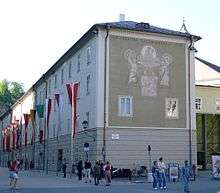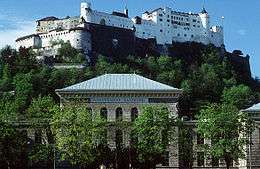University of Salzburg
The University of Salzburg, also known as the Paris Lodron University of Salzburg (German: Paris-Lodron-Universität Salzburg, PLUS), named after its founder, Prince-Archbishop Paris Lodron, is a public university in Salzburg municipality, Salzburg state, Austria. It is divided into four faculties:
Paris-Lodron-Universität Salzburg | |
 | |
Former names | Benediktineruniversität |
|---|---|
| Type | Public |
| Established | 1622 1962 (re-established) |
| Budget | € 112.8 million (2007) |
| Rector | Heinrich Schmidinger |
Administrative staff | 2,800 (2013) |
| Students | 18,000 (2013/2014) |
| Location | , , |
| Website | uni-salzburg.at |



Established in 1622, the university was closed in 1810 and re-established in 1962. Today, it has around 18,000 students and 2,800 employees and is the largest educational institution in Salzburg state.
Benedictine University
On 23 July 1622, Archbishop Paris Lodron appointed the scholar Albert Keuslin first rector of the Benedictine university. Keuslin, a graduate of the Jesuit University of Dillingen, had established the Akademisches Gymnasium, a secondary school, at Salzburg five years earlier. By resolution of Emperor Ferdinand II, issued on October 8, the Gymnasium was raised to a university. While the Thirty Years' War raged outside the Archbishopric of Salzburg, the university was built up and maintained by a federation of Benedictine abbeys from Salzburg, Switzerland, Bavaria and Austria. In its early years, courses taught were theology, divinity, philosophy, law, and medicine.
During the Napoleonic Wars, the Prince-Archbishopric was secularized as the Electorate of Salzburg in 1803. It was ruled by Archduke Ferdinand III of Austria, a brother of Emperor Francis I, who established a Faculty of Medicine. After Salzburg was annexed by the Kingdom of Bavaria in 1810, however, the university was closed on 24 December and replaced by a Lyzeum college with sections for divinity and philosophy, as well as a school for medicine and surgery. After the Napoleonic Wars, Salzburg became part of the Austrian Empire.
The divinity section was again converted to a faculty in 1850. In World War I, plans were evolved to relocate the Francis Joseph University from Czernowitz to Salzburg, though never carried out.
University of Salzburg
The University of Salzburg was not re-established until 1962, with a faculty of Catholic theology and a faculty of philosophy. Classes resumed in 1964, with a faculty of law added the following year. In 1975, a new federal law regulated the organisation of all Austrian universities. The University of Salzburg created four academic divisions: the Faculty of Catholic Theology, the Faculty of Law, the Faculty of Humanities, and the Faculty of Natural Sciences. A fifth division, the Faculty of Medicine, was not realized.
In 1995, the organisation of Austrian universities was further restructured with more faculty autonomy. The university gradually incorporated new academic programs through 2004 into 32 Fachbereiche or “departments”, and again, decided not to create a Faculty of Medicine.
Locations
The University of Salzburg has no central campus, occupying several buildings in Salzburg's historic centre: parts of the Salzburg Residenz building (Toskanatrakt) and on Kapitelgasse south of Salzburg Cathedral. The university library is located between the Kollegienkirche (the University Church) and the Großes Festspielhaus; attached to it is the Große Aula, or ceremonial hall.
The traditional faculty building of Humanities (Communication Studies, Sociology and Political Science) is located by the Rudolfskai, only 100 metres from Mozartplatz and Papagenoplatz. The Faculty of Sciences is housed in the second largest building in Salzburg after Hohensalzburg Fortress, and is located just further south next to Schloss Freisaal Castle and Frohnburg Castle.
Completeted in 2011, the Unipark Nonntal campus (replacing the old location at the Akademiestraße) is home to the departments of modern languages, and cultural and social sciences. The building is 17,000 square metres in size, with 5,500 students and 300 academic staff. There is a library and an Auditorium Maximum. Financing for the construction of the Unipark Nonntal was enabled by successful negotiations between Salzburg’s state governor Franz Schausberger and the Federal Ministry of Education.[1] Originally designed in 2002 by architects Storch Ehlers Partners, it was constructed in three years.[2][3]
 Unipark – south side
Unipark – south side- main entrance
 interior
interior lecture room
lecture room
Smaller university offices and institutes are scattered throughout the city, with arts and music being taught at the Mozarteum University Salzburg.
Alumni
- Hannes Ametsreiter (born 1967), Austrian telecommunication manager
- Martina Berthold (born 1970), Austrian politician
- Gabi Burgstaller (born 1963), Austrian politician
- Herbert Dachs (born 1943), Austrian political scientist
- Wolfgang Eder (born 1952), Austrian iron steel manager
- Renate Egger-Wenzel (born 1961), Professor of Old Testament
- Benita Ferrero-Waldner (born 1948), Austrian diplomat and politician
- Alexandra Föderl-Schmid (born 1971), Austrian journalist
- Karl-Markus Gauß (born 1954), Austrian novelist
- Toni Giger (born 1963), Austrian ski trainer
- Erich Hackl (born 1955), Austrian novelist and short-story writer
- Gerhart Holzinger (born 1947), Austrian constitutional lawyer
- Hannes Leitgeb (born 1972), Austrian philosopher and mathematician
- Hieronymus II. Lindau, (1657–1719), Abbot of Ochsenhausen Abbey
- Franziskus Klesin (1643–1708), Abbot of Ochsenhausen Abbey
- Erwin Kräutler (born 1939), Roman Catholic bishop
- Peter Launsky-Tieffenthal (born 1957), Austrian diplomat
- Alois von und zu Liechtenstein (born 1968), Liechtensteiner heir to the throne
- Andreas Maislinger (born 1955), Austrian historian
- Leopold Mozart (1719–1787), German composer
- Marie-Louise Nosch (1970-), Danish archaeologist
- Brigitta Pallauf (born 1960), Austrian politician
- Helga Rabl-Stadler (born 1948), Austrian politician and cultural manager
- Tobias Regner (born 1982) German singer, songwriter
- Astrid Rössler (born 1959), Austrian politician
- Abraham a Santa Clara (1644-1709), German Roman Catholic preacher and writer
- Franz Schausberger (born 1950), Austrian politician and historian
- Wolfgang Vyslozil (born 1945), Austrian media executive and lecturer
- Paulus Maria Weigele (born 1943), Abbot of Ottobeuren Abbey
- Beda Werner (1673–1725), Abbot of Ochsenhausen Abbey
References
- Robert Kriechbaumer: Umstritten und Prägend. Kultur- und Wissenschaftsbauten in der Stadt Salzburg 1986–2011. Böhlau Verlag, Wien, Köln, Weimar 2012, ISBN 978-3-205-78860-7, S. 215.
- Salzburgwiki
- salzburg-reiseinfo.com
External links
- University of Salzburg Website (in German)
- A brief Guide for International Students (2013) (in English)